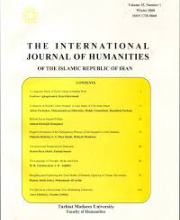۱.
The present study aims at exploring kinship terms and the different ways in which they are used to refer to and address relatives and non-relatives in Hawrami , an Iranian language spoken in Paveh, a border city in Kermanshah province. The relevant linguistic and cultural data are obtained primarily by one of the researchers as a native speaker of the dialect and through field works and interviews with native speakers. In addition to analyzing consanguineal and affinal terms, and words for step-relatives, some space is also devoted to discuss pragmatic aspects of the words, particularly in contexts where the terms are used to address relatives as well as non-relatives. Considering the fact that the authors came across no serious study of Hawrami kinship terminology, the present study might be one of the first preliminary steps to a better understanding of the cultural and anthropological aspects of this Iranian dialect.
۲.
This paper aims at describing the mechanism of German loanwords adaptation with respect to constraints of Persian language and within OT framework. Consequently the adaptation of consonant clusters and diphthongs as well as the phonemes substituted in loanwords will be examined. Prince and Smolensky’s (1993) Optimality Theory with its key notions of faithfulness and markedness constraints is suited to model this aspect of linguistic competence. So in this research a number of 30 German loanwords were selected as research data of which some were collected through the library method from written resources and the rest are the trade names of German Products that are collected through a field work. Descriptive analysis of the mentioned data within Optimality Theory comes into valuable linguistic conclusions such as: “In Persian, initial consonant clusters of German loanwords are broken up through vowel epenthesis which is mostly identical to the vowel of the second syllable.”
۳.
The Realization Optimality Theory is a recent development in the original Optimality Theory which is proposed to deal with morphological issues especially the inflectional ones. Its main idea is to consider the morphological realization rules as ranked violable language-specific constraints that control the realization processes and provide phonological information of grammatical morphemes. This article deals with the investigation of some morphosyntactic (inflectional) features of modern Persian in Realization Optimality Theory, and shows among the other things that it is a better model for treating inflection than the original Optimality Theory, but it still faces some problems with regard to a language like Modern Persian in which some morphosyntactic features are treated differently in formal and informal varieties, hence separate tableaux with different rankings of constraints are sometimes needed in order to select the optimal candidates in each of those varieties.
۴.
It seems that a great number of abstract religious concepts in Islamic texts are realized, both conceptually and linguistically, through cognitive strategies like metaphor and metonymy. This article tries to study the concept of death in the Holy Qurۥān, and Nahjul-Balāgha, the main Islamic Texts, to see how this (relatively) abstract concept is conceptualized in mind? Moreover, what component (s) of the recognized source concepts is (are) mapped onto the concept of death? The analysis of linguistic expressions about death shows that death is realized both metonymically and metaphorically in these two texts. There are structural, orientational and ontological metaphors in which death is the target domain of conceptualization, of which personification is more influential and specific than others. In all recognized metaphors, the death target is understood through different, but homogeneous, source concepts. The common component of nearly all these sources which is mapped on and highlighted is death power. Death has control over human and nobody can run away from it.
۵.
This paper is an attempt to explore the prepositions used to encode the agent in Persian passive constructions. According to Givón (1983) the main function of the passive constructions is to defocus the agent. As the general trend in Persian is to omit this defocused agent, we will stylistically divide the passive constructions into two main sub branches, namely unmarked and marked passives according to whether or not the agent is included. Having analyzed the prepositions using in the passive construction (e.g. t { v { ssot-e, be d { st-e, b A , { z suy-e, { z t { r { f-e, and be v { sile-y-e) a complete semantic characterization of the type of agent that normally occurs with these prepositions will be provided. The results indicate that, in contrast to some linguists who treated the prepositions in the passive construction as stylistic forms, they are not always interchangeable; in fact they are meaningful which have a prototype for the type of agent that co-occurs with them.
۶.
Autonomy plays a crucial role in the enhancement of important learning qualities in the learners. In that line of thinking, this study was launched to discover how English language learners exposed to an autonomously managed versus teacher controlled conditions would respond to the learning determinants. Two classes of English language learners at Isfahan University of Technology, Iran were thus treated under the two learning conditions. On the closing days of the semester, they were administered a questionnaire constructed based on three action phases of learning, namely, forethought, performance/volitional control, and self reflection. The questionnaire statements were rated on the Likert scale. The data analysis revealed that autonomy to a large extent determines the learners' views of learning. The class where autonomy was practiced showed a great deal of motivational boost or what is reinterpreted as forethought. The other two categories of learning, namely, their performance and self reflection, were also distinctly better perceived by the autonomous learners. The results point out the significance of preparing learners through autonomy for the prospective independent and critical learning.
